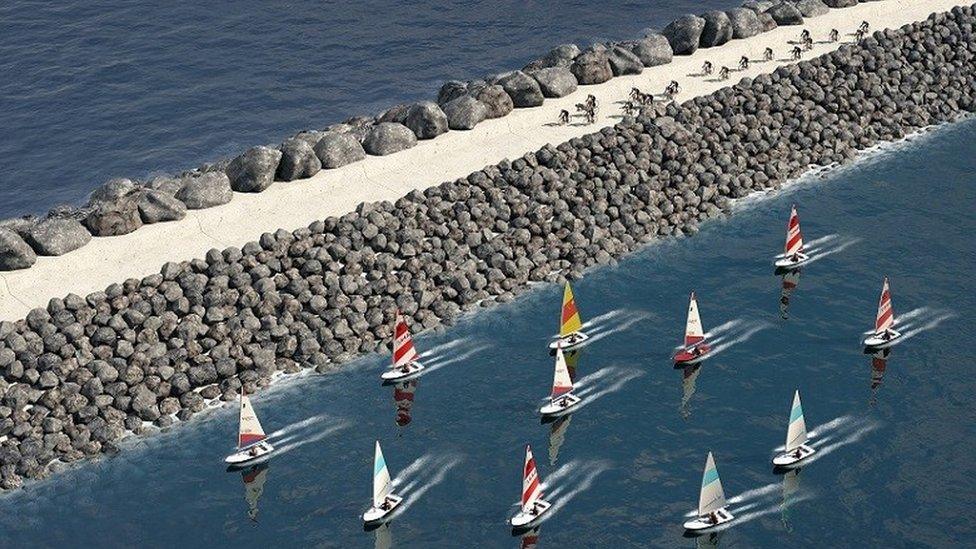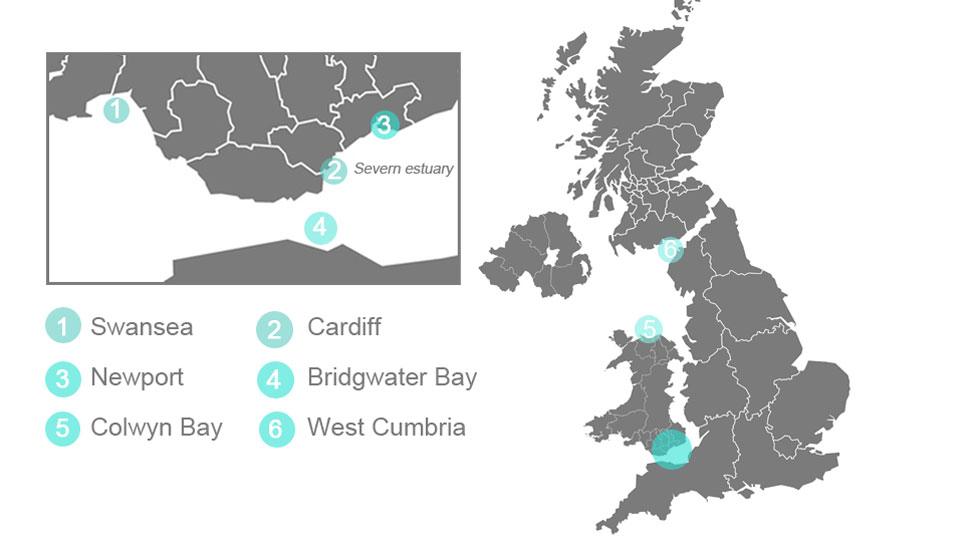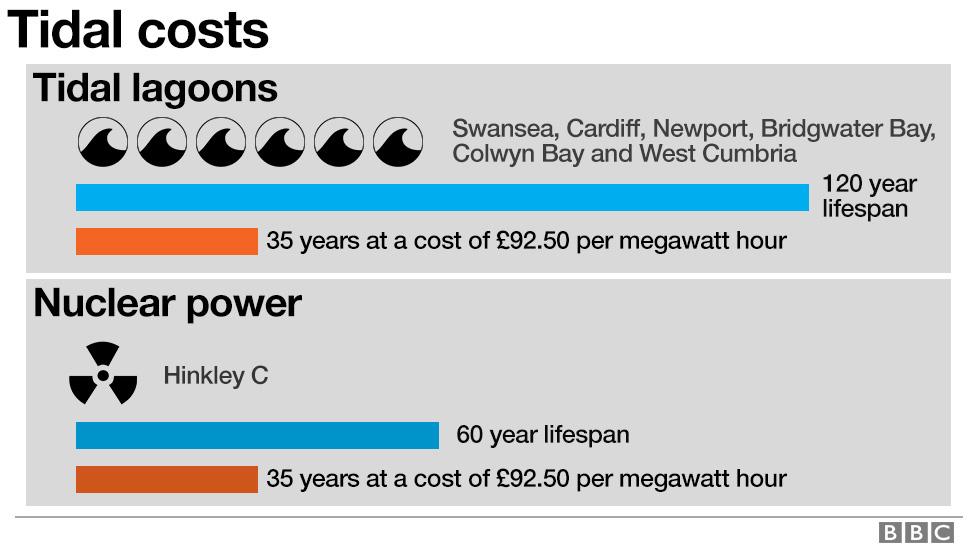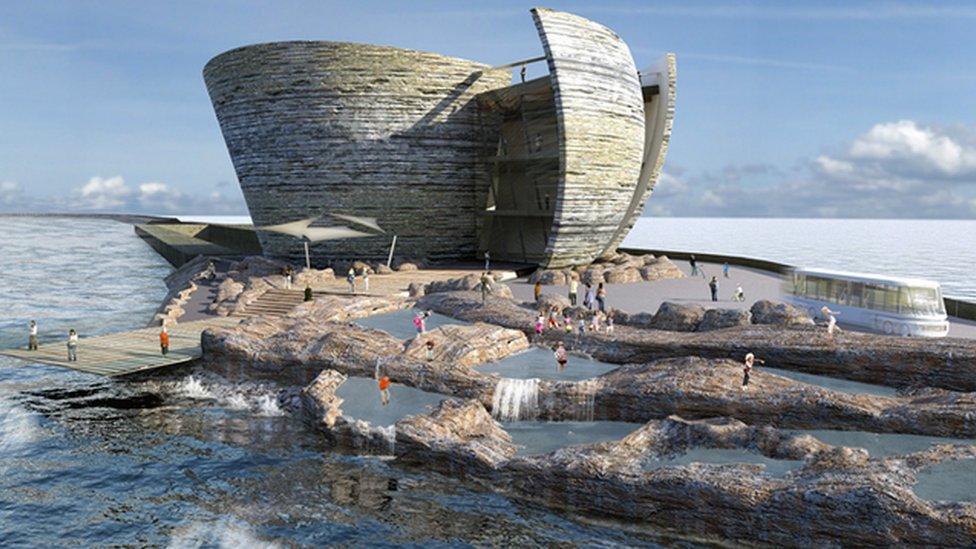Swansea Bay tidal lagoon: How the numbers were crunched
- Published

There is a lot of confusion about how much the tidal lagoon would cost and whether it would be worth it.
The UK Government - having already commissioned an independent review of the scheme's feasibility - says it has now done the number crunching.
So is the Swansea Bay proposal "twice as expensive" as Hinkley Point C as ministers have repeatedly claimed in recent months?

We understand that interpretation is based on adding up the capital costs - the upfront spending - on the entire fleet of six lagoons the developers are planning around the UK coastline.
It is thought to be in the region of £50bn while the bill for building the new nuclear plant at Hinkley currently stands at £20.3bn.
The reason they have included all six schemes in their calculations is that added together they would supply roughly the same amount of power as Hinkley C - around 7-8% of the UK's electricity demand.
The Swansea Bay lagoon itself would have been the initial test of the technology, costing £1.3bn to build and generating enough electricity for 120,000 homes.

Supporters of the project would argue that looking at things this way does not take into account the long life of the lagoons, which could still be generating electricity after 120 years. The Hinkley plant has a life expectancy of 60 years.
Indeed, former energy minister Charles Hendry - who carried out the review into tidal lagoons - warned of an "in-built bias" towards nuclear and other renewable technologies such as wind and solar if calculations around cost did not take into account the full operating life of the projects.
But given that the vast majority of the capital costs would be paid for by private investors anyway, why is the government so concerned?
It is because the companies backing the lagoon will not release funds until the developers have secured a contract with ministers guaranteeing them a specific price for the electricity produced.
And the so-called strike price that Tidal Lagoon Power (TLP) had asked for was highly unusual.
They had wanted a commitment over a long time period - up to 90 years - starting off at a very high price per megawatt hour of electricity generated.
It led to fears the government would tie itself in to supporting this innovative scheme for decades during which energy priorities might change and cheaper, more effective technologies could emerge.
In recent weeks, different figures have been touted - including a suggestion that the company could make the lagoon work for a similar strike price as was agreed with Hinkley Point C.
First Minister Carwyn Jones wrote to Business Secretary Greg Clark on 5 June stating that a £200m equity and/or loan investment from Welsh Government would allow for a contract on the same terms as was offered to Hinkley Point C - £92.50 per megawatt hour over a 35-year term.
But at a committee hearing a few weeks previously, MPs had questioned whether this amounted to adding a further subsidy from the Welsh Government on top of what would be offered from Westminster.
TLP denied this, but their chief executive Mark Shorrock admitted that without the Welsh Government's involvement a strike price closer to £150 megawatt per hour would be required.

You might like these stories too:

Consider the £57.50 per megawatt hour handed out to the latest offshore wind farms and you get to the heart of UK ministers' reluctance to do a deal with TLP.
We understand that they are also not convinced that future, larger lagoons would deliver the kinds of reduction in strike price that TLP have predicted.
Burnt by widespread criticism for the deal made with Hinkley Point C's developers, it is no surprise that the UK government appears to be putting affordability front and centre of its energy policy.
It has already stated publicly that it would not offer another contract with that level of subsidy.
Mr Clark, in his Commons statement,, external said he had been advised that:
By 2050, the lagoons would generate around 30 TWh per year of electricity - and could cost up to £20bn more to produce compared to generating that same electricity through an offshore wind and nuclear mix.
It could cost the average British householder up to an additional £700 between 2031 and 2050, or the equivalent of £15,000 for every household in Wales.
Behind the scenes, ministers say they have been talking to other companies which claim they can deliver similar tidal projects for a cheaper price though sources suggest these discussions are in the early stages.
Once wedded to TLP's vision to the point of including the Swansea Bay scheme in the Conservatives's general election manifesto in 2015, they now seem to have fallen firmly out of love with the lagoon.
The scheme's many champions though say ministers are making a "historic mistake" in turning their backs on this project, pointing to the urgent need to decarbonise the UK's energy supply if legally binding carbon emission targets are to be met.
- Published25 June 2018

- Published10 January 2018

- Published12 January 2017
